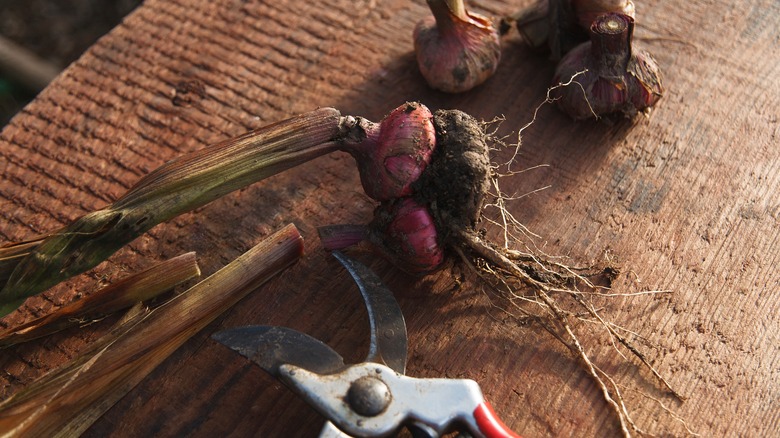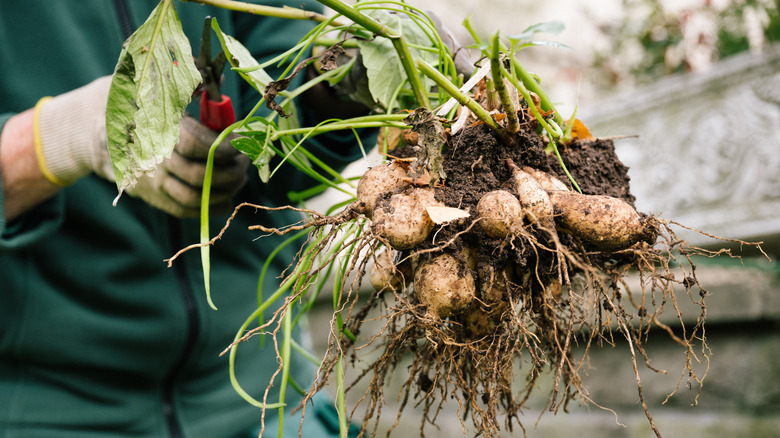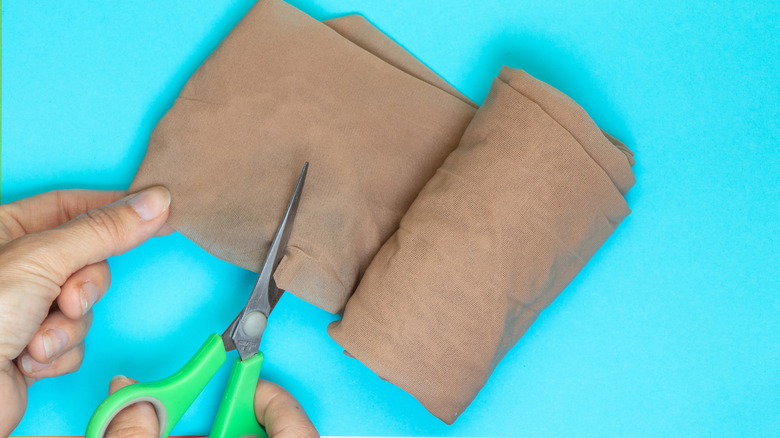The Item Of Clothing You'll Want To Use When Storing Bulbs For Winter
We may receive a commission on purchases made from links.
While many flowering bulbs survive winter under the soil and even the snow in most USDA Hardiness Zones, tender bulbs don't. Late summer and fall are typically harvest time for edible bulbs — you need to get them out of the ground and into long-term storage before they rot or freeze. How do you safely store your bulbs — tender, edible, or otherwise — for later planting or eating during the chilly months? It turns out that a pair of pantyhose is an excellent option. Apart from that, the usual dry produce storage advice applies here: keep them somewhere cool, dry, and dark, like a pantry, crawlspace, or corner of a (watertight) basement.
If you think you know every trick you need to know to grow your own garlic and onions — or any bulb plant (vegetable or floral), for that matter — think again. Popping recently harvested and dried bulbs in a length of pantyhose — old (but clean) or new — keeps them separated, reducing the spread of rot or disease. Hanging your bulbs also saves space and allows air to circulate, keeping damaging moisture at bay. The pantyhose stretches, accommodating bulbs of all sizes and shapes. Plus, a few pairs of tights won't break the gardening budget. Using old tights is free, or you can purchase pairs for just a few dollars.
Why it works
Pantyhose fabric resembles a very fine netting. The loose weave keeps the stockings sheer and helps them stretch for a close fit against the wearer's legs. The mesh-type material encourages airflow, which, combined with moisture-resistant fabric, keeps the bulbs dry. What's more, hanging your stocking-coated bulbs from a beam or hook uses far less space. It's a great solution for diminutive homesteads or condo-living balcony gardeners.
Protecting your plants from frost or snowfall using hosiery couldn't be easier. You can even store large tropical tubers, like elephant ear roots, in pantyhose. Stored allium bulbs, like onions and garlic, can give off a rotten egg smell due to the sulfur chemicals they contain but pantyhose can help keep unpleasant odors to a minimum.
There are a few downsides to this technique. Just as hosiery keeps out moisture, it can also potentially lock it in. Ensure bulbs are completely dry before tying them up, or you risk them rotting — especially those with a high water content and soft flesh like Vidalia onions.
The how-to
You don't want the pantyhose you use for storing your garlic or daffodil bulbs to cost the earth. Walmart has a four-pack of L'egg's pantyhose for $5.87. You can buy six pairs of MANZI sheer pantyhose for $15.99 on Amazon. If you want something that will last a few seasons, up the budget and shop at a specialist stocking brand like Sheertex. They have classic nude rip-resistant tights for $35 a pair on sale. You can, of course, use your own old nylons. However, buying or otherwise sourcing used pantyhose isn't advisable. Instead, check thrift stores or ask friends and family if they have any hosiery still in the package.
Using sharp scissors, cut the legs from your pair of pantyhose. Check your bulbs for signs of disease or damage, discarding any imperfect ones. Dust off leftover dirt. If the bulbs feel damp, leave them to dry for a bit longer. Sprinkle flower bulbs with fungicide powder; don't do this to bulbs you intend to eat. Thread the first bulb into the stocking top down — this reduces the chance of it sprouting. Knot the stockings between each bulb if you wish. Tie a label around each bulb stocking with the species or cultivar name and the date you strung them up. Store in a cool, dimly lit, dry part of your home or property with ambient temperatures of around 35 to 45 degrees Fahrenheit.


